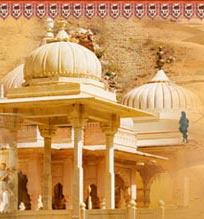 |
Read about the Kumbhalgarh wildlife sanctuary of Rajasthan. Kumbhalgarh wildlife sanctuary spans across Pali, Rajsamand and Udaipur districts.
|
Kumbhalgarh Wildlife Sanctuary
Kumbhalgarh Wildlife Sanctuary is located in the most rugged region of the Aravali Hills in Pali, Rajsamand and Udaipur districts of Rajasthan. It has been named after the impressive historic fort of Kumbhalgarh, which come into view over the Park. It is 578 sq Km in area and at an altitude of 500 to 1,300m. It is home to a very large variety of wild life, some of which are highly endangered species. The wild life includes wolf, leopards, sloth bear, hyena, jackal, jungle cat, smabhar, nilgai, chaisingh (the four horned antelope), Chinkara and hare.
The bird life at Kumbhalgarh is also gratifying. The normally shy and distrusted grey jungle fowl can be spotted here. Peacocks and Doves can be sighted regularly, feeding on grains scattered by the jungle guards. Bird like the red spur owls, Parakeets, golden Oriole, grey Pigeons, Bulbul, Dove and white breasted kingfisher can also be seen near the water holes.
Kumbhalgarh's natural beauty attracts many tourists and is accessible from Udaipur, which is 100 Km from here. Foot tracking and horse safari organized by local tour operators are quite popular. A typical safari route enters the sanctuary from the Kumbhalgarh Fort and cutting across the sanctuary it reaches Ghanerao, and then borders an old abandoned road. On this road, one can sight Chinkaras, Neelgais, four horned Antelope and many birds.
The bird life at Kumbhalgarh is also gratifying. The normally shy and distrusted grey jungle fowl can be spotted here. Peacocks and Doves can be sighted regularly, feeding on grains scattered by the jungle guards. Bird like the red spur owls, Parakeets, golden Oriole, grey Pigeons, Bulbul, Dove and white breasted kingfisher can also be seen near the water holes.
Kumbhalgarh's natural beauty attracts many tourists and is accessible from Udaipur, which is 100 Km from here. Foot tracking and horse safari organized by local tour operators are quite popular. A typical safari route enters the sanctuary from the Kumbhalgarh Fort and cutting across the sanctuary it reaches Ghanerao, and then borders an old abandoned road. On this road, one can sight Chinkaras, Neelgais, four horned Antelope and many birds.






